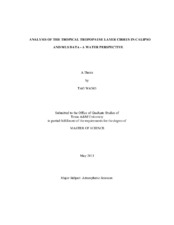| dc.description.abstract | Two mechanisms appear to be primarily responsible for the formation of cirrus clouds in Tropical Tropopause Layer (TTL): detrainment from deep convective anvils and in situ initiation. Here we propose to identify TTL cirrus clouds by analyzing water content measurements from the Cloud-Aerosol Lidar and Infrared Pathfinder Satellite Observations (CALIPSO) and Aura Microwave Limb Sounder (MLS). Using ice water content (IWC) and water vapor (H2O) abundances we identify TTL cirrus clouds that contain too much ice to have been formed in situ — and therefore must be of convective origin. We use two methods to infer amounts of water vapor available for in situ formation. Clouds with IWC greater than this threshold are categorized as being of convective origin; clouds with IWC below the threshold are ambiguous — they could either form from in situ or still be of convective origin. Applying the thresholds from December 2008 to November 2009, we found that at least 19.2% of tropical cirrus were definitively of convective origin at the tropopause (375 K) during boreal winter. At each level, we found three maxima in the occurrence of convective cirrus: western Pacific, equatorial Africa, and South America. Averaged over the entire tropics (30oS to 30oN), we found convective cirrus occurs more frequently in boreal winter and less frequently in boreal summer, basically following the a decreasing trend from DJF, MAM, SON, to JJA. During boreal summer, we found that only 4.6% of tropical cirrus come from convection. Sensitivity tests show that the thresholds derived at 390 K have the largest uncertainty. At lower levels, especially 375 K, our thresholds are robust. | en |


